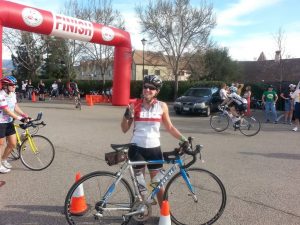|
Did you know that May was National Bike Month?
Although May is coming to a close, outdoor biking season is just beginning as the weather warms up and dries out. Rather you ride indoors or out, cycling is a great form of exercise and a lot of fun!
The bike was first created in Paris, France with a gain in popularity in the early 1800’s. It quickly became as American as apple pie and baseball. It’s funny to think that when kids starting wanting to ride bikes, parents were concerned that it was bad for the family. They felt it allowed too much independence and separation from each other and that it seemed physically dangerous. Like many new inventions do, it became more and more accepted and then celebrated. Now it’s hard to go anywhere around town or in a gym without seeing someone on a bike and for good reason!
In 1903 the Tour De France race started, giving riders a treacherous track through rain, wind, cobble stone, steep climbs and dangerous descents through the Alps and the Pyrenees. For 21 days and over 2,000 miles riders battle it out for the best time. It is interesting to note that in the early 1900’s it was believed that smoking cigarettes actually opened the lungs and could improve performance. Amazing right? Thankfully science prevailed and we know better now!
You don’t need to beat yourself up climbing steep mountains to get a great workout on a bike. The benefits are many, including the easiness on the knee and hip joints, cardio aerobic heart health and opportunities to meet new friends. As with any physical activity it comes with it’s own unique set of stresses on our bodies that can cause aches and pains if not properly addressed both before and after a ride.
Riding a bike uses almost all the major muscles groups, especially the calves, thighs, glutes, arms, shoulders and feet. According to The Active Times the 8 most common repeated use injuries cycling are in order of occurrence:
- Neck
- Knees
- Buttocks
- Hands
- Back
This isn’t including outdoor riding accidents that cause crashes. Any repeated movement can eventually become aggravating to any part of the body and even muscles that aren’t moving can become grumpy. The neck is a good example of that. Spending long periods of time in the same position carrying the entire weight of the head is going to take it’s toll. On longer rides, muscle fatigue sets in. Sometimes the pain and discomfort isn’t necessarily felt while on a ride, because the body has adapted to the situation to get you through it, but after the ride when you are trying to rest and recover, the pain creeps in. Muscle fatigue causes tightness and tightness can lead to strains and tears.
No cause for alarm! Muscles strains and tears usually clear up within days to weeks and there are ways to help move the healing process along quicker with self care.
Before Riding:
- Be well rested. Starting off fatigued will only make things worse.
- Hydrate – avoid alcohol the night before and drink water in the morning.
- Warm up – spend 10-15 min slow and easy before speeding up or climbing.
- Cool down – spend 10 min at an easy pace to allow the heart rate to normalize before stopping.
During Ride:
- Stay Hydrated – For longer rides include electrolytes to your hydration, like Gatorade.
- Keep good posture – Don’t slump, instead, roll shoulders and head back and breath!
- Listen to your body! Know when it’s time to slow down or stop. Be patient with yourself.
After Ride:
- Hydrate! hydrate! hydrate!
- Stretch all major muscle groups statically, holding each stretch at least 30 seconds.
- Massage – either self massage or preferably a professional sports massage.
Another great tip is to cross-training in between rides. Lift some weights, take a Pilates class or swim, anything that you enjoy to strengthen muscles in a different way than usual. This can help prevent fatigue from creeping up as quickly when on your ride, which will reduce the chances of strains and tears. Strong flexible muscles are less likely to experience fatigue and tightness as quickly as deconditioned inflexible muscles will.
These tips can be helpful for both an inside or outside ride. Despite following all these suggestions, muscle strains and tears can still happen. If so, gentle stretching, staying hydrated and sports massage can help speed your recovery. Kinesiology tape can also be helpful both before and after a ride for areas that are tender. If you see any swelling, be sure to ice it for 20 minute intervals as soon as possible. After 24 hrs heat might feel good and will increase circulation and loosen up tight muscles.
Despite the possible risks, cycling often becomes a healthy addiction for many people. It’s a fun way to exercise, meet new friends and if outside, experience the outdoors in a very rewarding way. Just be sure to prepare yourself before, during and after your ride to maximize your recovery time and get back on the bike as soon as possible for your next ride adventure!
 |
Tammara – Massage Therapist/Avid Cyclist
Blog Author |
Our rooms overlook the pool area.
Jacuzzi, steam room, sauna, showers & robes are available.

San Diego Tennis and Racquet Club
4848 Tecolote Rd. San Diego, Ca
|
